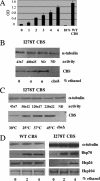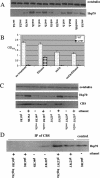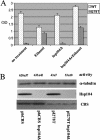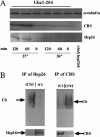Functional rescue of mutant human cystathionine beta-synthase by manipulation of Hsp26 and Hsp70 levels in Saccharomyces cerevisiae
- PMID: 19074437
- PMCID: PMC2640983
- DOI: 10.1074/jbc.M806387200
Functional rescue of mutant human cystathionine beta-synthase by manipulation of Hsp26 and Hsp70 levels in Saccharomyces cerevisiae
Abstract
Many human diseases are caused by missense substitutions that result in misfolded proteins that lack biological function. Here we express a mutant form of the human cystathionine beta-synthase protein, I278T, in Saccharomyces cerevisiae and show that it is possible to dramatically restore protein stability and enzymatic function by manipulation of the cellular chaperone environment. We demonstrate that Hsp70 and Hsp26 bind specifically to I278T but that these chaperones have opposite biological effects. Ethanol treatment induces Hsp70 and causes increased activity and steady-state levels of I278T. Deletion of the SSA2 gene, which encodes a cytoplasmic isoform of Hsp70, eliminates the ability of ethanol to restore function, indicating that Hsp70 plays a positive role in proper I278T folding. In contrast, deletion of HSP26 results in increased I278T protein and activity, whereas overexpression of Hsp26 results in reduced I278T protein. The Hsp26-I278T complex is degraded via a ubiquitin/proteosome-dependent mechanism. Based on these results we propose a novel model in which the ratio of Hsp70 and Hsp26 determines whether misfolded proteins will either be refolded or degraded.
Figures







Similar articles
-
Activation of mutant enzyme function in vivo by proteasome inhibitors and treatments that induce Hsp70.PLoS Genet. 2010 Jan;6(1):e1000807. doi: 10.1371/journal.pgen.1000807. Epub 2010 Jan 8. PLoS Genet. 2010. PMID: 20066033 Free PMC article.
-
Genetic and Pharmacological Modulation of Cellular Proteostasis Leads to Partial Functional Rescue of Homocystinuria-Causing Cystathionine-Beta Synthase Variants.Mol Cell Biol. 2023;43(12):664-674. doi: 10.1080/10985549.2023.2284147. Epub 2023 Dec 20. Mol Cell Biol. 2023. PMID: 38051092 Free PMC article.
-
Ubiquitin conjugation triggers misfolded protein sequestration into quality control foci when Hsp70 chaperone levels are limiting.Mol Biol Cell. 2013 Jul;24(13):2076-87. doi: 10.1091/mbc.E13-01-0010. Epub 2013 May 1. Mol Biol Cell. 2013. PMID: 23637465 Free PMC article.
-
Spatial sequestration of misfolded proteins as an active chaperone-mediated process during heat stress.Curr Genet. 2021 Apr;67(2):237-243. doi: 10.1007/s00294-020-01135-2. Epub 2021 Jan 1. Curr Genet. 2021. PMID: 33386485 Review.
-
How to fix a broken protein: restoring function to mutant human cystathionine β-synthase.Hum Genet. 2022 Jul;141(7):1299-1308. doi: 10.1007/s00439-021-02386-w. Epub 2021 Oct 12. Hum Genet. 2022. PMID: 34636997 Free PMC article. Review.
Cited by
-
Activation of mutant enzyme function in vivo by proteasome inhibitors and treatments that induce Hsp70.PLoS Genet. 2010 Jan;6(1):e1000807. doi: 10.1371/journal.pgen.1000807. Epub 2010 Jan 8. PLoS Genet. 2010. PMID: 20066033 Free PMC article.
-
Cystathionine beta-synthase mutants exhibit changes in protein unfolding: conformational analysis of misfolded variants in crude cell extracts.J Inherit Metab Dis. 2012 May;35(3):469-77. doi: 10.1007/s10545-011-9407-4. Epub 2011 Nov 9. J Inherit Metab Dis. 2012. PMID: 22069143 Free PMC article.
-
Methionine-deficient diet induces post-transcriptional downregulation of cystathionine β-synthase.Nutrition. 2010 Nov-Dec;26(11-12):1170-5. doi: 10.1016/j.nut.2009.10.006. Epub 2009 Dec 29. Nutrition. 2010. PMID: 20036517 Free PMC article.
-
Examination of two different proteasome inhibitors in reactivating mutant human cystathionine β-synthase in mice.PLoS One. 2023 Jun 15;18(6):e0286550. doi: 10.1371/journal.pone.0286550. eCollection 2023. PLoS One. 2023. PMID: 37319242 Free PMC article.
-
Genetic and Pharmacological Modulation of Cellular Proteostasis Leads to Partial Functional Rescue of Homocystinuria-Causing Cystathionine-Beta Synthase Variants.Mol Cell Biol. 2023;43(12):664-674. doi: 10.1080/10985549.2023.2284147. Epub 2023 Dec 20. Mol Cell Biol. 2023. PMID: 38051092 Free PMC article.
References
Publication types
MeSH terms
Substances
Grants and funding
LinkOut - more resources
Full Text Sources
Other Literature Sources
Molecular Biology Databases

